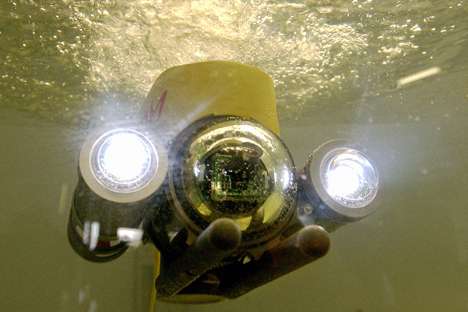A 2018 World Cup surprise – driverless Russian trucks

First unmanned KAMAZ vehicle may appear on Russia’s streets.
Press photoRussia plans to unveil its version of self-driving trucks when it hosts the FIFA World Cup in summer 2018. This surprising announcement was made by Russian Deputy Prime Minister Arkady Dvorkovich on October 4 at the STS Forum in Kyoto, Japan. What exactly the vehicles will do as part of the World Cup are yet to be specified.
Russia takes on the world
Russian car manufacturers have entered the race to build self-driving cars, and they plan special features that no competitor will offer. The playing field in this competition is already crowded by the titans of auto-manufacturing. In October, Toyota announced plans to bring self-driving cars to market by 2020, which is the year of the Tokyo Olympics. Daimler recently tested its self-driving tractor-trailer on public roads in a suburb of Stuttgart. Meanwhile, Honda, Tesla Motors and BMW are currently testing their own driverless cars in California, which is one of the few places in the world where no regulatory restrictions exist for such vehicles.
In Russia there are two companies working on self-driving vehicles – Rostec-owned KAMAZ, and Gaz Group, a part of the Basic Elements industrial group that belongs to Russian aluminum tycoon, Oleg Deripaska. Both manufacturers already stated that they would only be able to unveil the vehicle in three years if “the project is supported by the government.”
“We started developing our remote-controlled vehicle project based on cars produced by the Urals Automotive Plant, and provided that some government assistance is available we will be able to develop this project further and get a vehicle with full-fledged remote control and self-driving capabilities by 2018”, said Gaz Group vice-president, Elena Matveeva.
Meanwhile, KAMAZ has already received around $4.6 million in funding from Russia’s Ministry of Education and Science. The company is developing its driverless truck jointly with Russian software developer, Cognitive Technologies.
Olga Usova, president of Cognitive Technologies, told RBTH that the company is planning to produce its first prototype trucks at the factory in the Russian city of Naberezhnye Chelny. “Our driverless KAMAZ truck is currently capable of performing the more simple maneuvers — turns, U-turns, moving in a serpentine pattern, stopping in front of obstacles,” said Ms Usova.
Human vision for a robot car
Most international competitors are working on cars suited primarily for ideal traffic conditions and high-quality road surface markings, but Cognitive Technologies is taking the harsh conditions of Russia’s road network into account.
The KAMAZ and Cognitive Technologies project is based on the so-called passive, or signal-acquiring computer vision. This means that the vehicle’s computer vision system acquires data from the outside, and this data is then processed by the vehicle’s artificial intelligence to make decisions.
“In fact, this works in pretty much the same way as human vision does,” Usova explained. “Our eyes perceive the road and our brain analyses the environment and makes decisions. We developed a computer model of human vision, and our vehicles actually perceive the road and other vehicles.”
According to Usova, this is the project’s main feature, distinguishing it from most other driverless cars, including the Google Car, which are based on what she calls “signal-emitting design.” This concept involves using additional devices, such as radars, which use reflected light to measure distance, as well as various sensors. Cars of this kind navigate by emitting signals that reflect from the environment.
The U.S. and Europe are currently constructing smart highways, which come with perfect road markings and built-in sensors providing information about traffic. “This is the ideal environment, and our vehicle is also able to use radars but thanks to the algorithms implemented in our truck it can operate in Russian conditions, as well as on most of the world’s roads,” Usova said.
Cognitive Technologies believes that its self-driving KAMAZ truck project will make Russia one of the leaders on the international automobile market, especially in developing countries where the quality of road markings remains poor.
Read more: Driverless cars, sexy robots, and flying trucks – this is the future>>>
All rights reserved by Rossiyskaya Gazeta.
Subscribe
to our newsletter!
Get the week's best stories straight to your inbox
